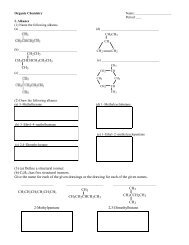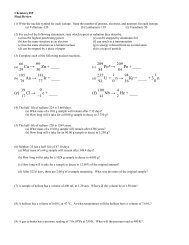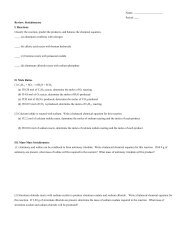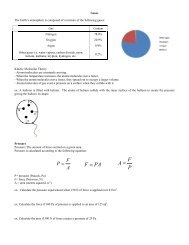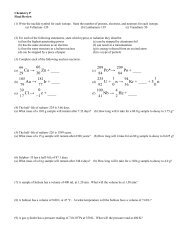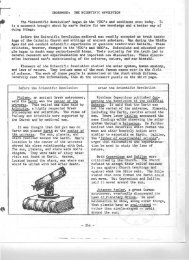*Religious Trends: The Great Awakening*- From the mid-1730s to the 1760s waves of religious revivalism swept through <strong>Am</strong>erica. These revivalistswere almost a counterpoint to the Enlightenment b/c they stressed feeling over rationalism.- The Great Awakening began in New England when in 1734 and 1735 Reverend Jonathan Edwardsnoted that his youthful members reacted to a Calvinist based message [people can only attain salvation bysurrendering <strong>com</strong>pletely to God’s will] which created intense emotion and release from sin.- The Great Awakening spread big time when George Whitefield [“the first modern celebrity”] from theChurch of England arrived and began touring the colonies and preaching to large audiences. He helpedunify the colonies, but he also created a split in religion between the “Old Lights” [traditionalists] and “NewLights” [revivalists]. This eventually led to increased toleration, though.- The reason for the resistance to the message of the Great Awakening was that it undermined thedependence on the clergy and was also radically egalitarian [which attracted many ordinary people].*Cultural Trends: Public Rituals*- Instead of reading about the Enlightenment, though, most people simply <strong>com</strong>municated orally, as manywere poorly educated or illiterate. Therefore, the <strong>com</strong>mon cultures of North <strong>Am</strong>erica were mainly oral,<strong>com</strong>munal and very local, since information traveled slowly and usually stayed w/in confined regions.- So, since the colonists couldn’t form a <strong>com</strong>mon culture through other means, religious and civic ritualsserved to unite them. For example, attendance at church was perhaps the most important ritual as it wascentral to <strong>com</strong>munity life and was handled in different ways depending on the region. For instance, inPuritan churches and in Virginia, people were seated w/respect to their positions in society; but in Quakermeetinghouses the seating was egalitarian.- Civic rituals also varied. In New England, colonial governments proclaimed official thanksgiving daysand days of fasting and prayer. Also, militia-training days served to bring the <strong>com</strong>munity together.- In the Chesapeake, however, important rituals occurred on court and election days, where people camefrom miles to observe the events.- In all areas of colonial <strong>Am</strong>erica, punishment of criminals in public also served to unite the <strong>com</strong>munityand also to remind everybody of the proper behavior by totally humiliating the criminal.- A new ritual at the time was the ritual of consumption, which is a fancy term for going shopping. This wasactually a new activity back then, since <strong>com</strong>mercial goods were only starting to be<strong>com</strong>e available for mostpeople. It became [and still is] customary, though, to buy cool stuff and then show it off. <strong>Am</strong>ong the rituals ofconsumption, though, the tea-drinking ritual was perhaps the most important.- Additionally, rituals developed for <strong>com</strong>munication and negotiation between settlers and Indians – giftgiving, etc. Unfortunately for the Indians the settlers soon realized that rum was a useful gift.*Colonial Families*- Families constituted the basic units of colonial society, but their forms and structures varied widely duringthe 18th century. The types of families included… Indian – dramatic changes for the Indians caused led to bands being reduced in numbers bydisease and the creation of new units. Old customs were often changed under pressure fromEuropean authorities and new circumstances, and extended families became more importantb/c of the high mortality rates. Mixed-Race – wherever the population contained a small number of European women, mixedrace families would appear [most frequently in the backcountry]. These families often residedin Indian villages, and their acceptance in mainstream society varied from area to area. European – in the 18th century most families were larger than families today, and theyincluded all the inhabitants of the house. Households worked together to produce goods foruse or sale, and the head of the household represented it to the outside world. Most familiesmaintained themselves through agriculture, and specific tasks were assigned to men andwomen. There was so much work that if there weren’t kids slaves or servants were needed. African-<strong>Am</strong>erican – usually African-<strong>Am</strong>erican families existed as parts of their Europeanhouseholds; most were slaves by the 18th century. Family links depended on the region:families were scarce in the North b/c there were so few blacks, and in the Chesapeake familieswere often dispersed [though wide kinship networks formed]. Sometimes these groups unitedagainst excessive punishment of members.- Besides differences in family life based on the type of the family, life in the cities was significantly differentfrom life in the country. City dwellers went to marketplaces [unlike their country counterparts, many of whomade it all themselves] and had more contact w/the outside world [newspapers, ports].8
*Colonial Politics 1700-1750: Relative Calm*- In the first decades of the century politics reached a new stability b/c of the creation of a new elite, whichdominated politics and kept things under control. In some areas, the elite worked together (Virginia), but inothers there was stiff <strong>com</strong>petition for office (New York). *1733 (NY) John Peter Zenger tried for criticizinggov’t actions; lawyer said truth could not be defamatory; he was released, setting a precedent for free press.- An important trend during the period was an increase in the power of the assemblies relative to the powerof the governors [“the power of the purse”]. Still, 18th century assemblies were very different from onestoday: they rarely passed new measures, but just saw themselves as acting defensively to prevent thepeople’s rights from being usurped by the governors.- By mid-century, many colonists had also begun linking their system w/the British one [governor=monarch,assemblies=House of Commons] and viewing the assemblies as the people’s protectors [even though theassemblies didn’t pay attention to the concerns of the poor and were not reapportioned for pop. changes].*Colonial Politics Continued: Internal Crises At Mid-Century*- So up to 1850ish things were going pretty well, politics-wise. But after that a series of crises demonstratedthe tensions that had been building [ethnic, racial, economic] that had been building in <strong>Am</strong>erican society andillustrated that the ac<strong>com</strong>modations reached after the Glorious Revolution were no longer adequate.- One of the earlier crises, the Stono Rebellion, occurred in South Carolina in 1739. One morning, twentyslaves gathered south of Charlestown and stole guns and ammunition from a store and then killed thestorekeepers and nearby families before heading towards Florida, where they hoped to find refuge. Althoughthe slaves were soon captured, this shocked the colonists and laws against blacks were made harsher.- The hysteria generated by the Stono Rebellion, <strong>com</strong>bined w/fears of Spain b/c of King George’s War,manifested itself most strongly in New York in 1741 when whites suspecting that a biracial gang wasconspiring to start a slave uprising [the New York Conspiracy] began a reign of terror. This showed that theassemblies were really unable to prevent serious disorder.- The land riots in New Jersey and New York certainly seemed to confirm that – for instance, the mostserious riots, which occurred in 1765/1766 around the Hudson River, occurred b/c in the 1740s NewEnglanders had arrived in the area and had started illegally squatting on the lands rented out to tenants bylarge landowners. After a family sued and the courts supported them, the farmers rebelled for a year.- Additionally, in the Carolinas the Regulator Movements occurred, in which backcountry farmers [mainlyScottish and Irish immigrants] rebelled against the provincial gov’ts b/c they felt they lacked influence andthat the gov’ts were unfair.Prelude to a Revolution (1754 – 1774)*Changes in Colonial Outlook*- So how was it that the happy colonists changed their minds and, after over a century of peacefulsubordination to Britain, began fighting for independence in 1776?- Many factors affected their change of opinion. It was in the 1750s that the colonists first began lookingaway from their internal politics and paying attention to British policies, and the story of the 1760s and early1700s is really a series of events that, one by one, widened the split.- But it really all began with the Seven Years War [a.k.a. King George’s War, the French and Indian War],which ended in 1763 and left North <strong>Am</strong>erica transformed.*The Seven Years War*- Anyhow, the Seven Years War informally began in July 1754 in the Ohio Valley when an inexperiencedGeorge Washington attacked the French, who were building a fort. The French kicked his sorry butt, so hesurrendered, but the incident still managed to eventually spark a major war in Europe and in <strong>Am</strong>erica.- Right before the war actually started, in June 1754, delegates from several colonies had met for theAlbany Congress, which had the goals of (1) convincing the Iroquois [who had always used their neutralityas a diplomatic weapon against all the sides involved] to join them and (2) coordinating colonial defenses.Neither goal was met b/c the governors of the individual colonies feared losing their autonomy.- So Washington had screwed up big time, and throughout 1755 the British [under Gen. Braddock], whodecided to attempt to kick the French out of N. <strong>Am</strong>erica, continued to get beaten by French & Indian forces.Their only success was the deportation of the French from Nova Scotia [they sent them to Louisiana].- After news of one particularly disastrous battle in 1756 the British and French formally declared war inEurope as well. Things still went badly in <strong>Am</strong>erica, partially b/c the British and colonial forces just didn’t get9
- Page 3 and 4: Congregationalists (Puritans) - The
- Page 5 and 6: - So the Restoration Colonies, form
- Page 7: - So in England, where they were lo
- Page 11 and 12: - Another ideology that was beginni
- Page 13 and 14: - The Quebec Acts were passed aroun
- Page 15 and 16: - So, by 1782, what had seemed to b
- Page 17 and 18: on the economic side, since the gov
- Page 19 and 20: - Anyway, Congress had several ques
- Page 21 and 22: - Adams was still in the early Wash
- Page 23 and 24: *Political Factionalism and Jeffers
- Page 25 and 26: - Samuel Slater set up the first te
- Page 27 and 28: - Court rulings extended the powers
- Page 29 and 30: Revival, Reform and Politics during
- Page 31 and 32: - Anyhow, during his administration
- Page 33 and 34: TEXAS (Southerners) - Texas had bee
- Page 35 and 36: - Anyhow, Pierce’s total support
- Page 37 and 38: They had a smaller everything: smal
- Page 39 and 40: - The two Northern victories at the
- Page 41 and 42: - The result was the Fourteenth Ame
- Page 43 and 44: The Slaughter-House Cases (1873) -
- Page 45 and 46: in the arrest of 8 immigrant radica
- Page 47 and 48: case (1897 - ICC can’t set rates)
- Page 49 and 50: - The Populists prepared to run aga
- Page 51 and 52: - MOST IMPORTANTLY, though, was the
- Page 53 and 54: - So, what led the US to undertake
- Page 55 and 56: - The rebellion, led by Emilio Agui
- Page 57 and 58: - Still, Americans managed to turn
- Page 59 and 60:
- So - the point of this episode? B
- Page 62 and 63:
*Hoover’s Response*- Poor Herbert
- Page 64 and 65:
- In FDR’s second term, however,
- Page 66 and 67:
Dominican Republic - When we left i
- Page 68 and 69:
World War II (1941 - 1945)*The Cour
- Page 70 and 71:
- So Truman started off again all c
- Page 72 and 73:
- First of all, the 1950s were (for
- Page 74 and 75:
peace w/Japan that ended occupation
- Page 76:
- France wanted out, so at the Gene





